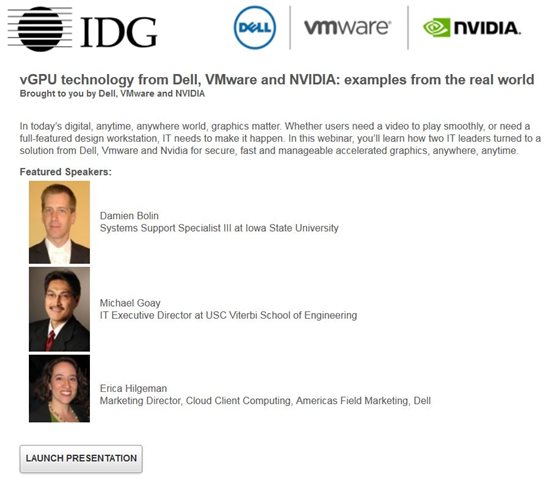Virtual desktops powered by VMware Horizon and NVIDIA vGPU cards are attracting renewed interest as IT departments in urban and rural settings recognize the value of deploying more sophisticated solutions. Iowa State University’s Department of Agronomy is among the forward-looking early adopters leveraging Dell Cloud Client-Computing solutions and Wyse endpoints to achieve several goals: streamlining IT management, providing users with more flexible access, and delivering workstation-class graphics.
Our PowerEdge rack servers paired NVIDIA vGPU with GRID technology run sophisticated design applications and handle the advanced rendering of 3D objects used in modern farming software. This provides the 1,000 active students learning how to optimize fertilizer loads and boost crop yields with a compelling workstation experience and remote access capabilities allowing them to work from home or wherever they feel most productive. It also gives the Agronomy Program more flexibility in configuring its existing lab facilities and serving more students in the university’s soil and farm-focused program, without requiring additional space or staff.
“I think the main driving factor for adoption was that I’m sort of a one-man show,” said Damien Bolin, the Department of Agronomy’s Systems Support Specialist managing the deployment. “Being able to consolidate everything that we offer into a VDI solution makes my world a lot easier to manage and also makes me a lot more effective overall. So, there was a business case for adopting a VDI solution with vGPU capability but we were also looking for the ability to better-educate students in their study of soil, feed genetics, and crop growth – basically teaching students how to feed the world – using the latest technology. We looked at VDI options that would allow us to incorporate mobility and network access across several devices. The ability to access assignments, computing resources and applications from anywhere using nearly any device is definitely an important trend.”
Iowa State University’s first implementation as part of NVIDIA’s vGPU Early Access Program was small, with three Intel-powered Dell PowerEdge servers running a VDI architecture based on VMware vSphere and Horizon. One of these servers was used to run the solution’s connectivity infrastructure while the others each contained NVIDIA GRID K1 cards to run users’ VDI sessions. Specifically, each server had 4-8 CPUs and 8-16GB of RAM, using local SSD for storage without a SAN.
“Those servers cover our four PC labs and our loaner laptops and our distance learning users,” explains Bolin. “It’s worth noting that these are not persistent users who are on the network all day long. Depending on the class and the time of day, we have a rotating user base of 100 to 200 students which makes it easier to manage than if you had all 1,000 users logging in all at one time.”
The solution’s faster time-to-value was also an attractive aspect to adoption. A 2014 study by the Iowa Board of Regents had recommended thin clients and VDI architectures to achieve IT cost-savings over time. Specifically, the savings is derived from efficiently streamlining IT management, consolidating datacenter hardware, and aligning endpoints. “When I first arrived we had separate systems for different programs at the school, especially for business education,” recalls Bolin. “The ability to incorporate everything in one resource has been invaluable.
“It gives us the ability to have students use a single log-in screen for their labs, classrooms, distance educating, and computing and makes things so much more efficient as far as managing the resources is concerned,” Bolin added. “Application compatibility and licensing has also been a breeze since we moved to this model, since live updates are no longer a huge deal. Instead of having to visit several labs to update software on individual machines, we can do updates through VDI and have all of our labs ready to go in just a few hours. And it also helps with getting requests from faculty to teach a new application. We’re able to do that on the fly now as well. And it improves security with having everything in the data center; that’s one of our big things is security.”
Of course, outside of academic environments, our Wyse Datacenter for Horizon with NVIDIA GRID K1 cards reference architectures can provide a compelling experience to knowledge workers as well as lower-tier “Power Users.” Our solutions deliver graphics capability to users who are sharing a graphics card or to higher tiers of users who need dedicated graphics for a more consistent level of screen rendering power. Regardless of the workload, Horizon and NVIDIA vGPU technology delivers a true desktop workstation experience for the discerning graphics professional working in a virtualized environment.
In a real-world deployment, our solution has allowed Agronomy program students to perform advanced simulations and projections, including complex meteorological analysis. “Another thing about GRID is that it is actually a true GPU hardware sharing solution,” explains Bolin. “We experienced excellent app performance and the VDI experience is really like a local desktop.”
Regarding the deployment Bolin commented: “I had worked with VMware infrastructures before but had never implemented them,” he said. “We collaborated with the central IT system here which will eventually be utilizing vGPU-enabled virtual desktops. The documentation was excellent for the setup and with the E.A.P. I was able to get our infrastructure up in a couple of days and have people testing it and connecting to it, which was a pretty big deal. I have read through a lot of IT documentation and this was pretty easy to follow and it made sense.”
“Over the last four years my experience with Dell has been great as far as the service and support we’ve received,” concluded Bolin. “With NVIDIA, I’ve been following the GRID launch and reading about it before it went live so when I saw the VMware trial come up I felt we had to jump on the opportunity to see all three elements, including Dell, in action together.” We appreciate the partnership that Iowa State University’s Agronomy Department has shown with Dell, VMware, and NVIDIA, and look forward to learning more together about graphics-enabled desktop virtualization. Our innovative solutions will continue to reduce cost and complexity while providing a better user experience on our best-in-class thin and zero client endpoints.
For more information, please contact Erica Hilgeman, Education Specialist in Dell’s Cloud Client-Computing Group, at erica_hilgeman@dell.com
To listen to the full presentation regarding NVIDIA vGPU technology from Dell, VMware, Intel and NVIDIA and how your organization can leverage secure, fast and manageable accelerated graphics, anywhere, anytime, please click on the image below:

